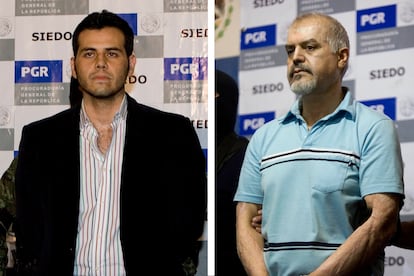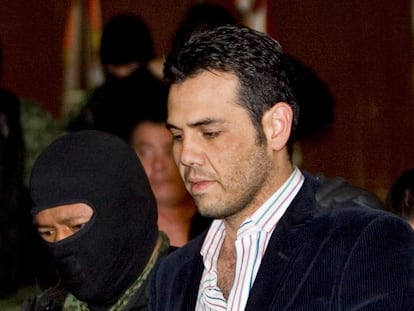Prison releases signal the return of Mexico’s drug lords from the 1990s
The US has agreed to free rival narc bosses Vicente Zambada and Eduardo Arellano Felix in exchange for insider information about the Mexican underworld

In the early 1990s, Mexico lived through the bloody rivalry between the Sinaloa cartel and the Tijuana cartel, in the country’s first major narco war. The fallout would leave a nation strewn with corpses and lay a path for every other conflict that has come since. Until then, drugs in Mexico had been controlled by a tight group of allied criminal organizations, which split into factions following the arrest of drug boss Miguel Ángel Félix Gallardo. His nephews would go on to lead the Tijuana cartel, also known as the Arellano Félix cartel, while infamous Mexican narco trafficker Ismael “El Mayo” Zambada led the Sinaloa cartel. The intense rivalry between these criminal organizations would change Mexico forever.
This year, the United States will release Vicente Zambada, the first-born son of El Mayo, along with Eduardo Arellano Félix, one of the seven siblings who took over from their uncle in the rival group. The collaboration agreements with US justice, particularly concerning the cartels dealings with the Drug Enforcement Administration (DEA), mean that the pair will not spend the rest of their lives in jail. Zambada betrayed his own father in 2019, revealing everything he knew about the cartel at Joaquín “El Chapo” Gúzman’s trial in New York, even after being groomed to serve in it since birth. Vicente had been extradited in 2010 and cooperated with the authorities since then; although the latter have not confirmed a date, he either has been already released or will soon be at some point this year. Although Eduardo Arellano Félix played a smaller role in the Tijuana cartel, he acted as informant and his sentence is due to expire in August.
El Mayo’s hatred for the Arellano brothers is infinite...for a man like Ismael Zambada, it is a matter of honor that there be a reckoningAnabel Hernández, journalist
The release of these two big-name drug traffickers will revive the bloody battle of the 1990s in Mexican collective memory. This was a war that went beyond money, territory and border control into more ancient concepts of honor and blood feuds. The main proponent of this brutal score-settling was Vicente’s father, “El Mayo” Zambada, the undisputed head of the Sinaloa cartel. El Mayo is the only boss of his generation never to have been arrested despite trafficking drugs for more than half a century. He planned and executed the bloody war against the Arellano Félix family.
The criminal empire controlled in the 1980s by the Sinaloa cartel, then known as the Juarez cartel, included a series of territorial pacts that the war against the Arellano Félixes would blow up years later. Miguel Ángel Félix Gallardo, Ernesto Fonseca Carrillo (Don Neto) and Rafael Caro Quintero established business links with Pablo Escobar’s powerful organization in Colombia, and there were also tacit agreements with other cartels on Mexico’s northern border for drug trafficking.
The turning point came with the brutal murder of DEA agent Kiki Camarena in 1985, as the agency laser-focused on Mexican narcotraffickers to avenge their own. Don Neto was arrested in 1985; Félix Gallardo was captured in 1989 and is still serving a sentence in Mexico, and Caro Quintero, accused of direct involvement in the kidnapping, torture and execution of agent Camarena, was arrested in 1985 in Costa Rica. Quintero was released after a controversial ruling by Mexican courts and is currently unaccounted for, but the DEA is still after him. A year ago it put a bounty on his head of $20 million, its highest ever reward for a criminal’s capture.
With the heads of the organization arrested by the end of the 1980s, its singular control began to waver. El Mayo, one of the oldest associates of the Guadalajara cartel, allied with El Chapo to control key trafficking routes, and engaged in a battle whose legacy has been revived with the release of Vicente and one of his eternal rivals, Eduardo Félix Arellano.
In Baja California, local newspapers said there were only two types of dead: Sinaloans and Arellanos
Vicente’s father, El Mayo, lived in the border city of Tijuana in the early 1990s with the aim of preventing the bloodthirsty Arellano Félix brothers, led by Benjamin and Ramón (two of seven children), from taking power over this key strip of land. The Arellano Félix brothers responded by trying to murder Vicente, initially in 1991 when he was just 16 years old, according to Anabel Hernández, author of a book about him entitled El Traidor (or, The Traitor). The conflict intensified with El Chapo’s misdeeds aimed at maintaining their stronghold, leading to bloody attacks with a level of violence never before seen in Mexico.
The war between the Sinaloa and Tijuana cartels may have set the stage for later wars between the Beltrán Leyva and Zetas crime syndicates, but it was the first great narco conflict. In Baja California, local newspapers said there were only two types of dead: Sinaloans and Arellanos. The city became a macabre graveyard, with dismembered people hanging from bridges. It also became one of the world’s most dangerous places to live. The battle intensified further when El Chapo and his lieutenant “El Güero” Palma tried to kill Ramón Arellano Félix at a nightclub called Christine in Puerto Vallarta, but botched the hit and killed six others instead. El Güero is now also awaiting release at age 61, after spending 26 years in prison.
The violence spilled over even further into the lives of the cartel families. The Arellano Félix brothers ordered a hitman to seduce El Güero’s wife, which he succeeded in doing, meanwhile infiltrating the cartel. The hitman killed her and sent her head to El Güero in a refrigerated box. Then El Güero’s children, who were four and five years old, were thrown off a 150-meter high bridge in Venezuela. He received a videotape of their deaths.
The peak of this confrontation came with the death of Cardinal Juan Jesús Posadas in the parking lot of Guadalajara Airport in 1993, caught in the crossfire between members of the Arellano gang and those working for El Chapo. The Mexican government blamed the clergyman’s death on El Chapo himself, catapulting him to global fame. He had until that point only been known for his vicious attacks on the Tijuana cartel, and was arrested that year in Guatemala, although he escaped from prison for the first time in 2001.
The early 2000s also marked the decline of the Arellano Félix family. In 2002, Ramón was gunned down at a carnival in Mazatlán, in Sinaloa state. A week later, his brother Benjamin was arrested and went on to be sentenced in the United States to 25 years for drug trafficking. The youngest brother Francisco Javier, also known as “El Tigrillo,” was left as leader of the cartel, but he was arrested in 2006 by the US Coast Guard while fishing on a yacht 25 kilometers off the coast of Baja California. He was given a 23-and-a-half year sentence in the United States.
If he is released in August, Eduardo Arellano Félix, alias “El Doctor”, is the heir presumptive of a criminal organization on the verge of extinction. Along with his sister Enedina and his son, he had continued the business when the rest of the brothers were killed or jailed. Hernández, the journalist, said he should not count on El Mayo forgetting about him. “El Mayo’s hatred for the Arellano brothers is infinite. That does not mean that with Eduardo’s release a war will begin, as the Arellanos barely exist and no longer have the capacity to confront the powerful Sinaloa cartel. But for a man like Ismael Zambada, it is a matter of honor that there be a reckoning,” she said.
Another one of the brothers, Rafael Arellano, who was freed in 2008 after his capture in 1993 and extradition to the United States, was shot and killed by a hitman dressed as a clown in 2013 in Los Cabos, Baja California. The Arellanos were already by then just a specter of Mexican drug trafficking’s bloody past, but it didn’t matter when he went out in public.
As another member of the Tijuana clan stands to be released in August, the long reach of the cruel war of the 1990s could yet be felt.
Tu suscripción se está usando en otro dispositivo
¿Quieres añadir otro usuario a tu suscripción?
Si continúas leyendo en este dispositivo, no se podrá leer en el otro.
FlechaTu suscripción se está usando en otro dispositivo y solo puedes acceder a EL PAÍS desde un dispositivo a la vez.
Si quieres compartir tu cuenta, cambia tu suscripción a la modalidad Premium, así podrás añadir otro usuario. Cada uno accederá con su propia cuenta de email, lo que os permitirá personalizar vuestra experiencia en EL PAÍS.
¿Tienes una suscripción de empresa? Accede aquí para contratar más cuentas.
En el caso de no saber quién está usando tu cuenta, te recomendamos cambiar tu contraseña aquí.
Si decides continuar compartiendo tu cuenta, este mensaje se mostrará en tu dispositivo y en el de la otra persona que está usando tu cuenta de forma indefinida, afectando a tu experiencia de lectura. Puedes consultar aquí los términos y condiciones de la suscripción digital.
More information
Archived In
Últimas noticias
Most viewed
- Sinaloa Cartel war is taking its toll on Los Chapitos
- Oona Chaplin: ‘I told James Cameron that I was living in a treehouse and starting a permaculture project with a friend’
- Reinhard Genzel, Nobel laureate in physics: ‘One-minute videos will never give you the truth’
- Why the price of coffee has skyrocketed: from Brazilian plantations to specialty coffee houses
- Silver prices are going crazy: This is what’s fueling the rally










































